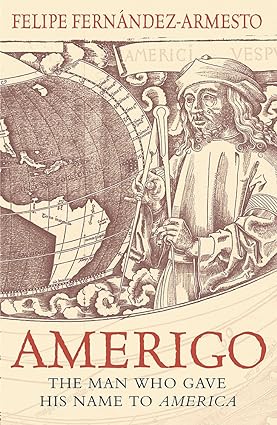Amerigo

In 1507 the cartographer Martin Waldseemuller published a world map with a new continent on it which he called ‘America’, after the explorer and navigator Amerigo Vespucci. The map was a phenomenal success and when Mercator’s 1538 world map extended the name to the northern hemisphere of the continent, the new name was secure, even though Waldseemuller himself soon realised he had picked the wrong man.
This is the story of how one side of the world came to be named not after its discoverer Christopher Columbus, but after his friend and rival Amerigo Vespucci. Born in Florence in 1454, Vespucci had spent his youth as a dealer or agent for the great Medici family. Then in 1491 he followed his fellow-Italian Columbus to Seville. In Seville he continued as a Florentine agent but also helped Columbus get his ships ready for his second and third voyages. Although Amerigo himself later sailed on at least two voyages of his own and explored the coast of present-day Brazil, he excelled above all at self-invention and self-promotion. He saw himself as an explorer and navigator of genius, and his colourful travel writings sold much better than those of Columbus. He became Pilot Major of Spain in 1508 and died in 1512.
Fernández-Armesto knows this period exceptionally well and he brings wonderfully to life the world of navigators, shipwrights, explorers, cartographers, agents, financiers and fixers.
